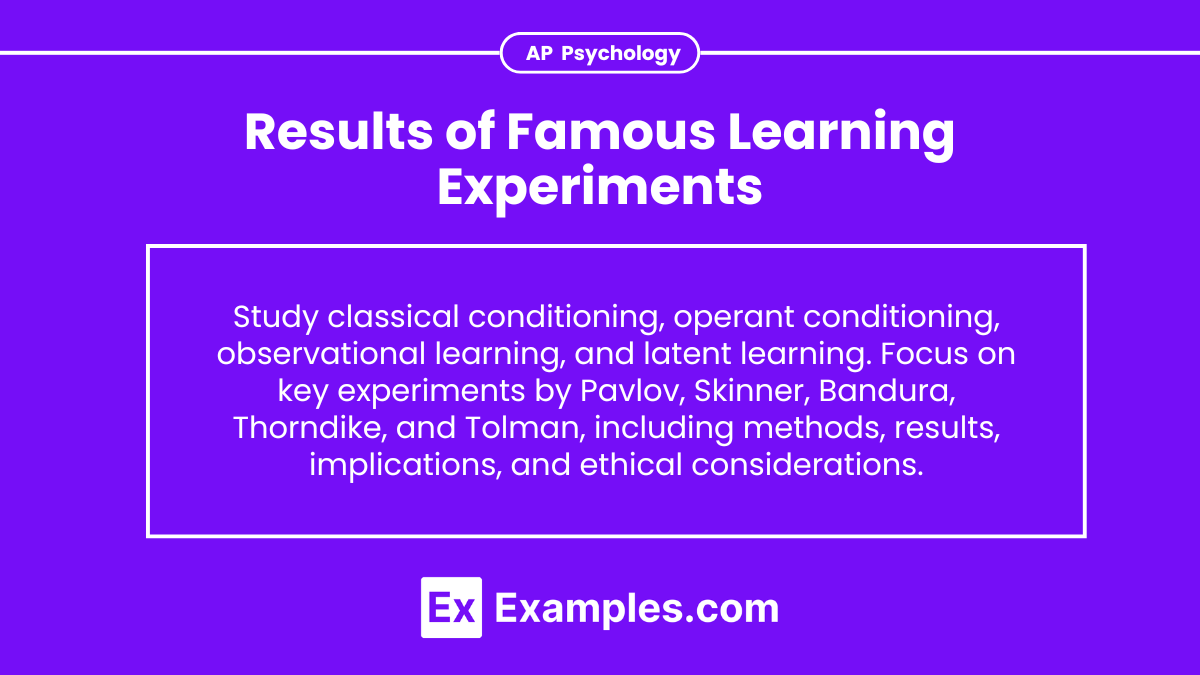Understanding the results of famous learning experiments is crucial for success in AP Psychology. These landmark studies conducted by researchers like Ivan Pavlov, B.F. Skinner, Albert Bandura, and Edward Tolman have significantly shaped our knowledge of how learning occurs. Through classical conditioning, operant conditioning, observational learning, and latent learning, these experiments reveal the mechanisms by which behaviors are acquired and modified. Exploring these foundational experiments provides insight into the principles of associative learning, reinforcement, and cognitive processes, all of which are essential concepts for the AP Psychology exam.
Learning Objectives
Understand the principles of classical conditioning, operant conditioning, observational learning, and latent learning. Be able to describe key experiments by Pavlov, Skinner, Bandura, and Tolman, including their methods, results, and implications. Analyze how these experiments demonstrate learning processes and behavior modification. Recognize the ethical considerations and applications of these findings in real-world contexts. Develop critical thinking skills to evaluate the impact of these experiments on psychological theories and practices.
1. Pavlov’s Classical Conditioning Experiment
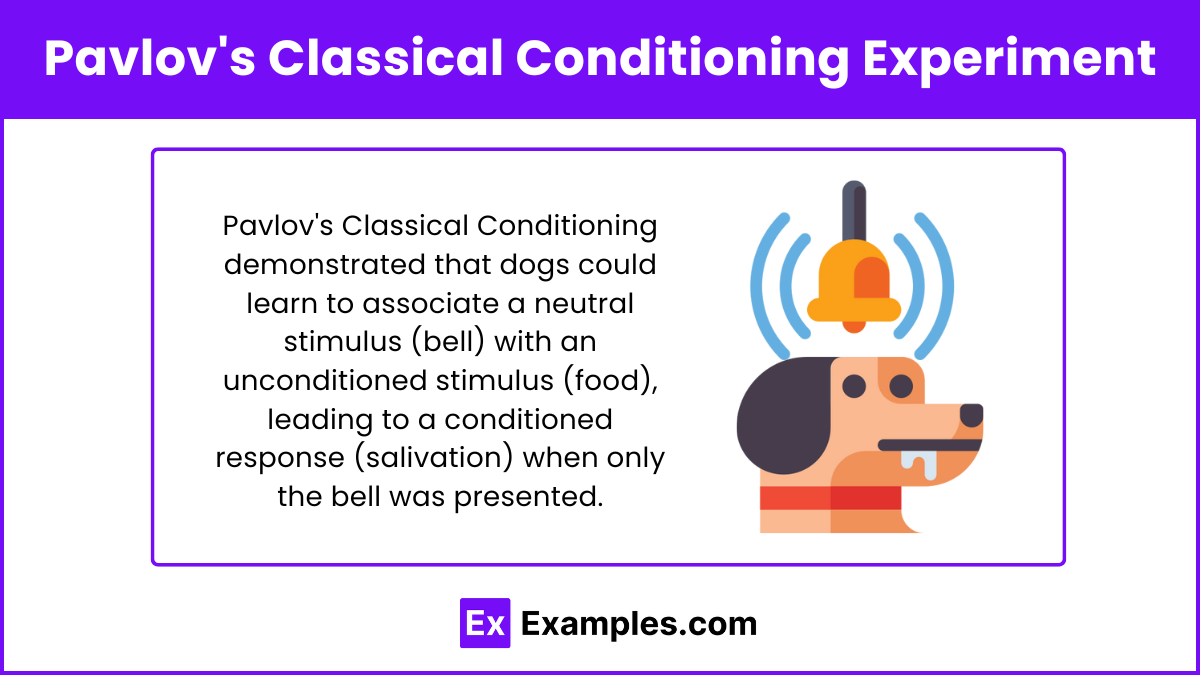
Researcher: Ivan Pavlov
Objective: To investigate how a neutral stimulus can become associated with an unconditioned stimulus to elicit a conditioned response through classical conditioning.
Method
- Baseline Measurement: Pavlov initially observed that dogs naturally salivated when presented with food (unconditioned stimulus, UCS). This salivation was an unconditioned response (UCR).
- Neutral Stimulus Introduction: Pavlov introduced a neutral stimulus (NS), a bell, which initially did not cause the dogs to salivate.
- Pairing Stimuli: Pavlov repeatedly rang the bell (NS) just before presenting the food (UCS) to the dogs.
- Formation of Association: After several pairings, the dogs began to associate the bell with the food.
- Conditioned Response: Eventually, the dogs started to salivate (conditioned response, CR) in response to the bell alone (conditioned stimulus, CS), even when no food was presented.
Results
- Conditioned Response: The dogs salivated in response to the bell, demonstrating that a neutral stimulus (the bell) had become a conditioned stimulus through association with an unconditioned stimulus (the food).
- Acquisition: The process of learning the association between the bell and food is called acquisition.
- Extinction: If the bell was repeatedly presented without the food, the conditioned response (salivation) gradually diminished, a process known as extinction.
- Spontaneous Recovery: After a rest period, the conditioned response could reappear when the conditioned stimulus was presented again, a phenomenon known as spontaneous recovery.
- Generalization: The dogs sometimes responded to stimuli similar to the conditioned stimulus (e.g., different sounding bells), illustrating stimulus generalization.
- Discrimination: Over time, dogs could learn to distinguish between the conditioned stimulus and other similar stimuli if the similar stimuli were never paired with the unconditioned stimulus.
2. Skinner’s Operant Conditioning Experiment
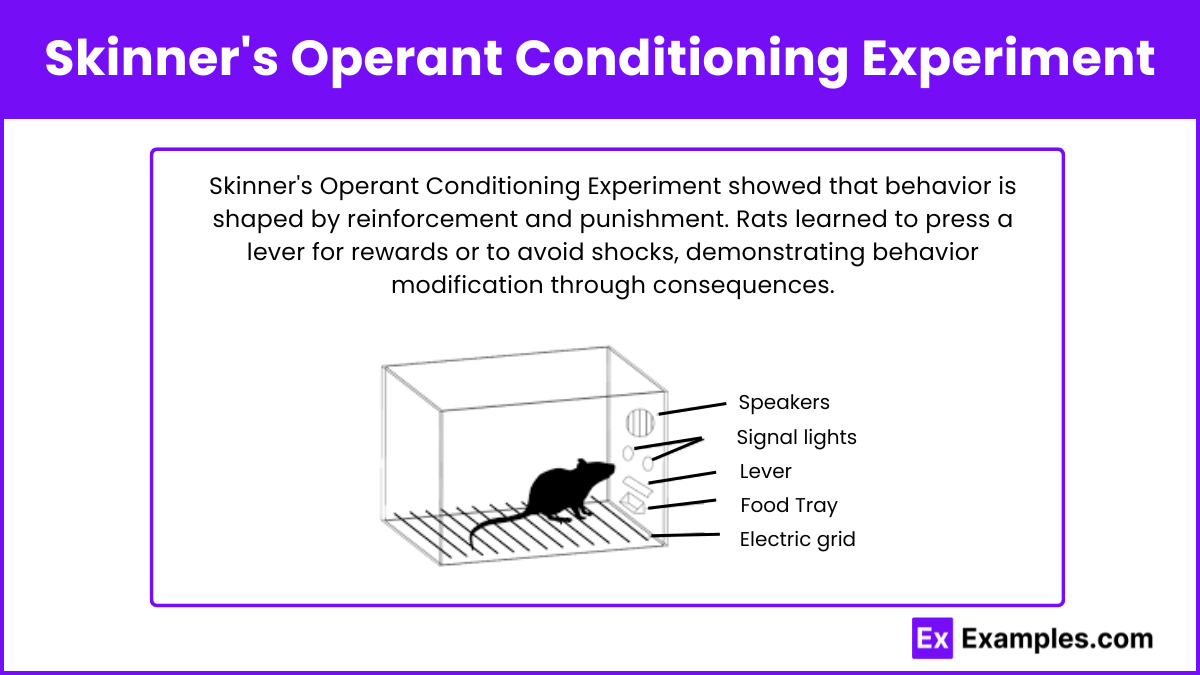
Researcher: B.F. Skinner
Objective: To investigate how behavior is influenced by its consequences through reinforcement and punishment, and to understand the regeneration of behavioral patterns.
Method
- Skinner Box: Skinner designed an apparatus known as the “Skinner box” to study animal behavior in a controlled environment. This box typically contained a lever or button that an animal could manipulate.
- Reinforcement:
- Positive Reinforcement: When the animal pressed the lever, it received a food pellet. This reward increased the likelihood of the lever-pressing behavior.
- Negative Reinforcement: Skinner also used a version where the animal could turn off an unpleasant electric shock by pressing the lever. Removing the negative stimulus also increased the behavior.
- Punishment:
- Positive Punishment: Skinner sometimes administered a mild shock following a specific behavior to decrease the occurrence of that behavior.
- Negative Punishment: The removal of a pleasant stimulus (e.g., taking away food) following a behavior to reduce its occurrence.
Results
- Behavior Shaping: Skinner demonstrated that animals could learn complex behaviors through a process called shaping, where successive approximations of the desired behavior were reinforced.
- Schedules of Reinforcement:
- Continuous Reinforcement: Providing a reward after every desired behavior led to rapid learning but also rapid extinction if the reward ceased.
- Partial Reinforcement: Reinforcing the behavior intermittently led to slower acquisition but greater resistance to extinction. Common schedules included fixed-ratio, variable-ratio, fixed-interval, and variable-interval schedules.
- Extinction: If reinforcement stopped, the behavior eventually decreased. However, the rate of extinction depended on the reinforcement schedule.
- Generalization and Discrimination: Animals could generalize the learned behavior to similar stimuli or discriminate between different stimuli if trained accordingly.
3. Bandura’s Bobo Doll Experiment

Researcher: Albert Bandura
Objective: To investigate the impact of observational learning on children’s behavior, particularly aggression, and to understand the symbiosis between observed behaviors and behavioral responses.
Method
- Participants: The experiment involved 72 children (36 boys and 36 girls) aged 3 to 6 years old from the Stanford University Nursery School.
- Experimental Setup: The children were divided into three groups:
- Aggressive Model Group: Children observed an adult behaving aggressively towards a Bobo doll, including hitting, kicking, and using a hammer.
- Non-Aggressive Model Group: Children observed an adult playing calmly with toys and ignoring the Bobo doll.
- Control Group: Children did not observe any model.
- Observation Phase: After watching the models, children were taken to another room filled with various toys, including the Bobo doll, to observe their behavior.
- Imitation Measurement: Researchers measured the extent to which the children imitated the behavior they had observed, specifically noting aggressive actions toward the Bobo doll.
Results
- Imitation of Aggression: Children who observed the aggressive model were more likely to exhibit aggressive behaviors towards the Bobo doll compared to those in the non-aggressive model and control groups.
- Gender Differences: Boys displayed more physical aggression than girls, but both genders exhibited verbal aggression. Additionally, boys were more influenced by male aggressive models than female aggressive models.
- Novel Aggressive Behaviors: Children also displayed new forms of aggression not previously exhibited by the models, indicating that they were not only imitating but also learning to generalize the aggressive behavior.
- Non-Aggressive Behavior: Children in the non-aggressive model group and control group exhibited significantly less aggressive behavior.
4. Watson and Rayner’s Little Albert Experiment
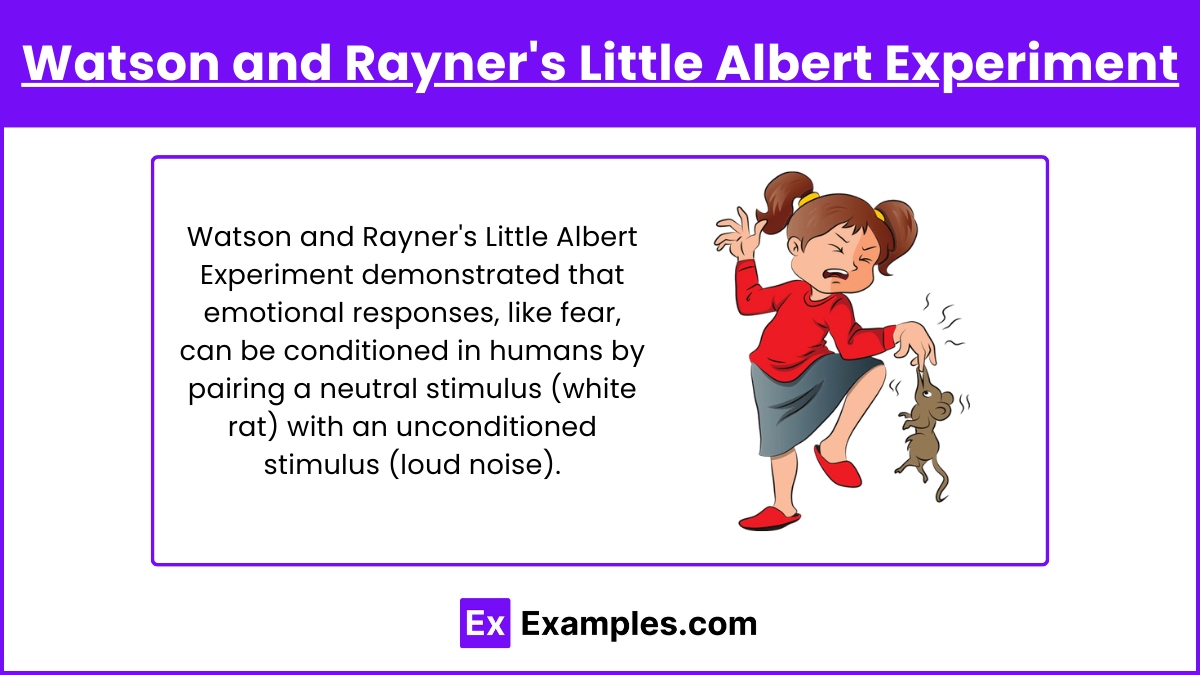
Researchers: John B. Watson and Rosalie Rayner
Objective: To investigate whether emotional responses could be conditioned in humans within a psychological ecosystem.
Method
- Participant: “Little Albert,” an infant approximately 9 months old.
- Initial Testing: Albert was exposed to various stimuli (e.g., a white rat, a rabbit, a dog, masks) to determine his baseline reactions, which were generally neutral with no signs of fear.
- Conditioning Phase:
- Unconditioned Stimulus (UCS): A loud noise made by striking a steel bar with a hammer, which naturally caused Albert to cry (unconditioned response, UCR).
- Neutral Stimulus (NS): A white rat, which initially did not elicit a fear response from Albert.
- During the conditioning trials, Watson and Rayner presented the white rat (NS) to Albert and, simultaneously, produced the loud noise (UCS). This pairing was repeated several times.
- Post-Conditioning Testing: After several pairings, Albert was presented with the white rat alone to observe his reaction.
Results
- Conditioned Response (CR): After conditioning, Albert began to show fear (crying, avoidance) in response to the white rat alone, indicating that the previously neutral stimulus had become a conditioned stimulus (CS) eliciting a conditioned response (CR).
- Generalization: Albert’s conditioned fear response generalized to other similar stimuli, such as a rabbit, a dog, a fur coat, and even a Santa Claus mask with a white beard. This demonstrated that the learned fear extended beyond the original conditioned stimulus.
- Extinction: The experiment did not include an extinction phase, so it is unclear how long Albert’s conditioned responses persisted without reinforcement.
5. Thorndike’s Puzzle Box Experiment

Researcher: Edward L. Thorndike
Objective: To study the process of learning in animals through trial and error and to formulate the Law of Effect.
Method
- Participants: Cats.
- Experimental Setup: Thorndike used a “puzzle box,” a small cage with a lever or string that the cat had to manipulate to escape and obtain a food reward placed outside the box.
- Procedure:
- A hungry cat was placed inside the puzzle box.
- The cat could see and smell the food outside but could only reach it by figuring out how to escape the box.
- Thorndike recorded the time it took for the cat to escape the box over multiple trials.
Results
- Initial Trials: At first, the cat’s movements were random and uncoordinated. It would eventually stumble upon the correct action (e.g., pressing the lever) that opened the box.
- Learning Process: With repeated trials, the cat learned to escape more quickly. The time it took to perform the correct action decreased steadily.
- Trial and Error: The cat’s learning was characterized by a gradual reduction in time needed to escape the box, suggesting that learning occurred through trial and error rather than sudden insight.
6. Tolman’s Latent Learning Experiment
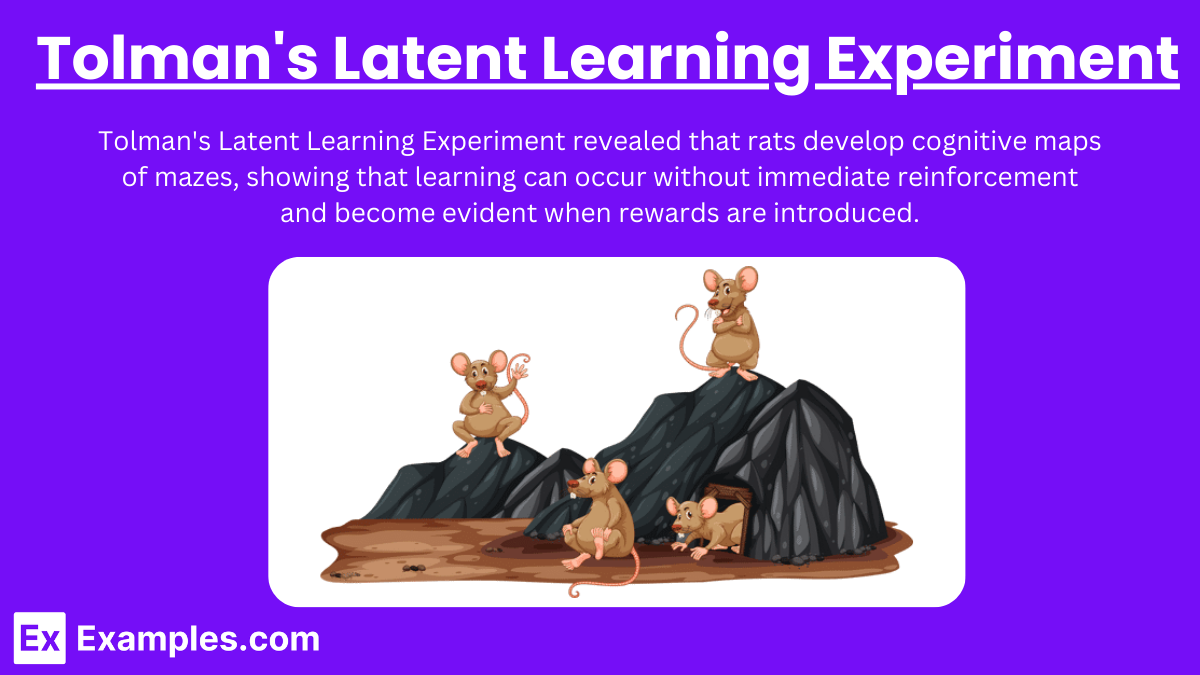
Researcher: Edward C. Tolman
Objective: To investigate whether learning can occur without immediate reinforcement and to explore the role of cognitive processes in an organism’s learning.
Method
- Participants: Laboratory rats.
- Experimental Setup: Rats were placed in a maze with several pathways leading to an end goal (a food reward).
- Groups:
- Group 1 (Continuous Reward Group): Rats received a food reward every time they reached the end of the maze.
- Group 2 (No Reward Group): Rats never received a food reward upon completing the maze.
- Group 3 (Delayed Reward Group): Rats did not receive any reward during the initial trials but began receiving a food reward after a set number of trials (e.g., after the 10th trial).
Results
- Group 1: Rats in the continuous reward group quickly learned to navigate the maze, showing a steady improvement in performance.
- Group 2: Rats in the no reward group showed minimal improvement in navigating the maze, indicating little to no learning without reinforcement.
- Group 3: Rats in the delayed reward group showed little improvement initially, similar to the no reward group. However, once they started receiving a reward, their performance dramatically improved, often surpassing that of the continuous reward group.

